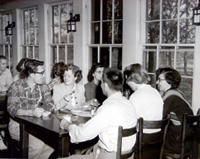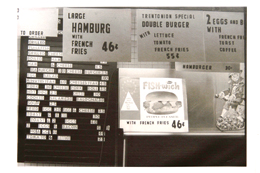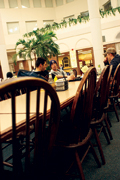Then and Now
Dining halls
The next time you overhear a current TCNJ student bemoan his or her dining hall experience, share this morsel of information with him or her: students from the College ’s earliest days had to supply their own napkins, napkin rings, knives, forks, and spoons. They also didn’t have a dining hall in which to eat, but instead broke bread with the families who boarded them during the school year.
Things have changed a bit since then. When the College moved to Ewing in 1931, officials decided a central dining hall was needed. The Hillwood Inn, a former restaurant that stood on the new college grounds, was deemed the best fit, and it served that purpose for the next 24 years.

Dining at the Inn durring the 1950s.
© TCNJ Archives
In 1955, Phelps Hall replaced the Inn as the campus’s grub hub. Students at the time were sad to see the Inn go. “That atmosphere of friendliness once conveyed by its deep brown wood and rough brick fireplace is absent from our evening meals these days, ” lamented the 1956 Seal editors.
But over time students came to accept Phelps for what it was: the only “safe place to get a meal on campus,” Greg Caiola ’79 laughingly recalled. He explained that whereas there was always an element of mystery about what was being slopped onto your tray in other dining halls, “You could always count on the meals in Phelps because the place had a deli, and you can ’t mess up a bologna and cheese sandwich.”

Menu board from the Pub.
© TCNJ Archives
The 1970s and 1980s saw dining halls open in Decker, Travers/Wolfe (T/W), and the Student Center. While many alumni might remember Decker Dining Hall for its dungeon-like atmosphere and mystery-meat specials, Tom Lazarro ’88 had a different take on the place. “Decker had the absolute best hangover food. It was a fried food smorgasbord!”
Jennifer Harnett ’93 didn’t share Lazarro’s fondness for the food in Decker. Harnett, now the women’s swimming and diving coach at TCNJ, confessed that during her freshman year, when she was assigned to eat in Decker, she ’d often call for delivery instead, and can still recite the number for Two Brother ’s Pizza. She moved into T/W the following year and said the food there was much better.
However, what really sticks out in her mind about her dining hall experiences are the hours she’d spend in the cafeterias every weekend chatting and catching up with friends. That is a sentiment shared by many alumni.
T/W and the Student Center dining halls are still going strong. Community Commons (now called Eickhoff Hall) replaced Phelps, and its 800-seat, sky-lit cafeteria made the Decker Dining Hall obsolete. Nowadays, there is also the Library Caf é, which serves beverages and sandwiches. If nothing else, students these days have plenty of choices about where to eat on campus.

Dining in Eickhoff.
© John Davis
Much like their predecessors, though, today’s students see the dining halls not only as places to go for one-star food at five-star prices, but as havens in which they can relax with friends between classes and catch up on the latest goings-on. In the process, they are making memories that will last for years to come —and the fact that they get free, unlimited utensils and napkins just makes the experience that much better.
They still have to bring their own napkin rings, though.
Tony Marchetti ’96, ’02


